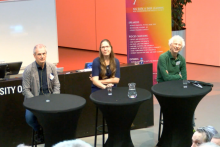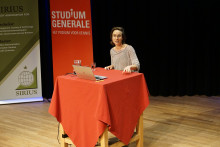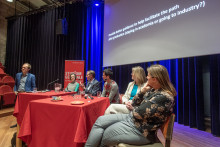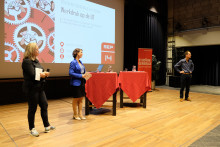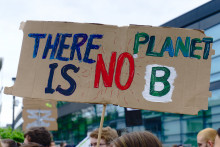‘We need to make a big step in investment and do something bigger’
The first speaker of the evening is Peter Bauer of the European Centre for Medium-Range Weather Forecasts. Using the IPCC report, which ‘reflects present knowledge on climate science of the past’, Bauer discusses current gaps in model reliability which need to be filled. ‘Models agree about warming and anthropogenic contribution is certain’, meaning it’s very clear human actions are involved in climate change. But ‘models start disagreeing about hydrological predictions and dynamic predictions’, meaning water and wind behaviour are still uncertain. Specifically, ‘models have not been able to describe . . . El Niño and El Niña’ and ‘this is a very real issue’, since understanding the behaviour of these storms can potentially save many lives. ‘We need to close that gap’, says Bauer, ‘we need to make a big step in investment and do something bigger’.
‘There’s a lot of variability around this mean and that is what we call the weather’
Karin van der Wiel, director of KNMI, is the second speaker of the evening. She zooms in from Bauer’s more international view and looks at the situation in the Netherlands. Even though ‘models agree about warming’, science is uncertain what climate change ‘will do to local variations’. She explains that since the climate is ‘very rarely at the average . . . there’s a lot of variability around this mean and that is what we call the weather’. However, weather disasters are especially extreme variations from this average, so ‘if I want to investigate a 1 in a 100 year heatwave, there are not many datapoints’. This can be improved, she explains, by using ‘large ensemble techniques’, which ‘run the same simulation with different settings’, providing multiple possible occurrences of extremes. These are ‘fantastic to really look at these climate extremes in a robust way’, she says, ‘but they cost ‘a very large computing requirement’. Thus van der Wiel advocates for more funding to be put into this.
‘We need much more climate science, not necessarily more money’
While the previous two speakers advocated for more funding to help them make better models and computer simulations, the third and final speaker, Ad Lagendijk of the UT and UvA, has different ideas. Lagendijk claims that while ‘simulations are sometimes the only way to obtain results . . . there are limitations to simulations’. According to him, climate science ‘need[s] models, to solve it by understanding the physics’, and currently there are ‘many simplifications’. He points out that ‘one climate cell is the size of the Netherlands’. According to his estimations, there are only ‘1372 climate scientists’ in the world, a number ‘ridiculously low for such a major problem’. Lagendijk’s final message is: ‘We need much more climate science, not necessarily more money’.


